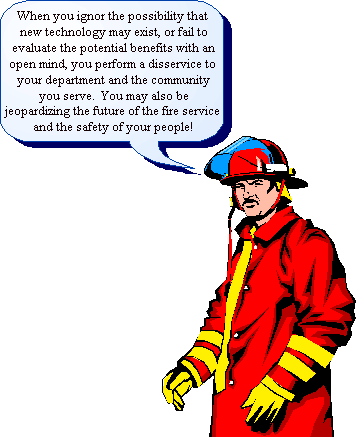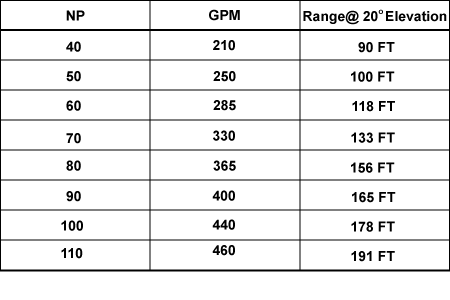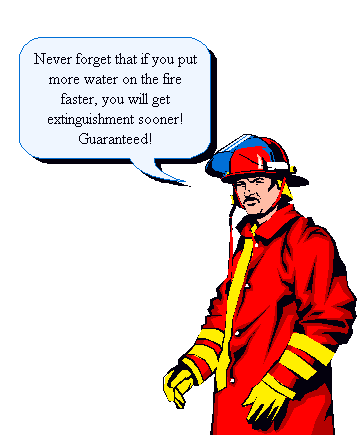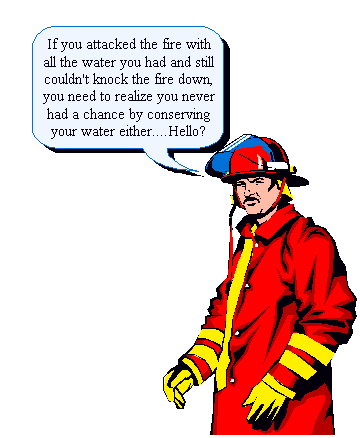Frequently Asked Questions
I. What determines fire suppression?
According to the NFPA, extinguishment by cooling with water is determined by:
- Volume of water available
- Rate of application
- Type of stream applied
The volume or amount of water available will determine the size of fire you can extinguish. The rate of application is self-explanatory. The type of stream refers to heat absorption. The two common ways of increasing a stream’s heat absorption is by breaking the stream into smaller droplets and increasing the number of droplets by increasing your gpm. To be effective, the water droplet must be formed near the base of the fire, or be large enough to have sufficient energy to reach the seat of the fire despite air resistance, the force of gravity, and the fire thermal column. When droplets are too small they can be deflected by the fire plume, or be evaporated before they reach the base of the fire. A water droplet stream used in a heavy smoke environment will improve visibility by the attachment of carbon particles in the smoke to the water droplets thus removing them from the air.
There are two well known nozzles in the fire service, the smooth bore and the combination, which may be a basic spray, constant gallonage, automatic or a constant/select gallonage as is recognized by NFPA 1964.
A new patented nozzle, the Vindicator, has now jumped right into the middle of the age-old controversy regarding the smoothbore and combination nozzles. Let’s look at the options we now have in nozzles one at a time and how they affect the items we’ve discussed.
The advantages of the smooth bore nozzle are high flow rates, less nozzle reaction, more mobility, and less steam generation. Because it’s a solid stream, we have less surface area to absorb heat, which is compensated for by breaking up the stream by deflecting it off the walls or ceilings. It’s the high flows that help make up for its lack of heat absorption, thus making it a good choice as an attack nozzle. One problem you should be aware of is what happens when it’s not operated at its recommended pressure (50 psi NP for hand lines & 80 psi NP for Master streams). If the nozzle is under-pressurized, the result is an inadequate gpm flow and a stream that loses its effective reach. If it’s over-pressurized the stream breaks up as soon as it leaves the tip. The end result is that you may not be delivering enough gpm to the fire because of loss from wind, gravity, and evaporation from the thermal column.If you’re using this type nozzle, ensure that you are properly pressurizing the nozzle. The failure to do so may mean you lose that first three-minute round.
One of the combination nozzle’s advantages is the high heat absorption because of the broken stream, which offers more water droplets (surface area). However, we give up this property greatly when we switch to straight streams. They can typically handle being over-pressurized, yet flows drop dramatically when they are under-pressurized, as was previously mentioned. A combination nozzle is more effective than a smooth bore on fires involving flammable liquids and it can provide protection for firefighters, in certain situations. Large volumes of air can be moved, which is useful in ventilation. Keep in mind this same ability may spread the fire, create a thermal inversion, and cause steam burns to fire fighters and/or victims if not used properly.
If you’re using this type of nozzle we recommend annual performance testing with a flow meter. You should also provide your people with a thorough education of the nozzle’s characteristics when operated both properly and improperly.
The Vindicator satisfies the requirements of both a high rate of application and a broken stream for high heat absorption. It operates at 50 psi NP, which means it has the reaction characteristics of a smooth bore yet it will operate at nozzle pressures as high as 125 psi. The increase in nozzle pressure will give you more gpm and more range. Due to the low nozzle pressure, you have the benefit of mobility with less fire fighter fatigue and less ware on your equipment. The fact that it Vindicator supplies an air-aspirated stream makes it an excellent choice for flammable liquid fires and foam applications. The water droplets from the Vindicator are large droplets and are less affected by wind or thermal columns. Thus, it allows more water to be placed on the flame-fuel interface.
If you’re using this type of nozzle, we’re confident you have discovered numerous advantages that we haven’t mentioned. Even so, never become lax in your training on the equipment’s abilities. We do encourage you to make your personnel aware of the differences between the Vindicator and a combination nozzle regarding flows. If you are accustomed to using the Vindicator, beware when you revert to a hand line with a conventional type nozzle. The flow rates are considerably less even though you are using the same size line and your expectations may not be met. Your own testing will confirm this.
II. How do flow rates compare?
Flow rates for smooth bore nozzles are obviously determined by the size of the bore and the pressure. The most commonly used tip sizes for a 1¾" hose are the 7/8" and 15/16", which flow 161 gpm and 185 gpm respectively at 50 psi NP. Common smooth bores for a 2½" hose line are the 1" or 1¼", which flow 211 gpm and 330 respectively at 50 psi NP.
There is a vast selection of combination nozzles and flow rates available. You may choose from a constant gallonage, selectable gallonage, or an automatic with numerous flow selections within each type. Combination nozzles for 1¾" lines are capable of flows in the 200-gpm range and 350 gpm can be obtained with 2½" lines. The problem is that many never see this flow because of the common practice of depressurizing the hand line due to lack of manpower. The combination nozzle offers a wide variety of options, but you must supply the right nozzle pressure to it or it may not perform properly.
There are three models of Vindicators designed for hand line operation and one for monitors. The Vindicator doesn’t regulate at one given nozzle pressure. They are designed to operate between 50-100 psi NP. Within this range they will provide an effective flow and stream reach.
Vindicator Light Attack, 90-200 gpm for standard hand line operations. For use on 1½" and 1¾" hose. Capable of 95 gpm at 50 psi. NP and 200 gpm at 100 psi. NP.
Vindicator Heavy Attack, 175-425 gpm for heavy hand line attack units. Capable of 250 gpm at 50 psi. NP through 1¾" hose and 425 gpm at 100 psi. NP through 2½" hose.
Vindicator Blitz Attack, 250-500 gpm for 2½" hand lines. Capable of 325 gpm at 50 psi. NP through 2½" hose and 500 gpm at 100 psi. NP.
Vindicator Master Attack, 675-1000 gpm for monitors. 1000 gpm @ 85 psi. NP. Operating nozzle pressure ranges from 65 psi up to 125 psi for this model.
If you’re thinking that these flows are not possible, you’re right, if you’re using conventional nozzle technology. Keep in mind, the Vindicator is a patented breakthrough in nozzle design and delivery capabilities(See Figure 2).


III. How much range does the stream have?
What needs to be stressed is the importance of an effective stream for the purpose of suppression. There are nozzles capable of fairly good range, yet what type of stream is left for actual fire fighting at that range? It may look good on the 6 o’clock news, but is it effective for the task at hand? A recent discussion with a fire department’s R&D division revealed that they were considering going to 2,000 gpm nozzles for their monitors. You ask, Why? It’s simple. They realized that the 1000 gpm nozzles were not providing near the flow at the seat of the fire that was needed. Why? Remember; wind, gravity, and evaporation from the thermal column affect your stream. By going to a higher flow nozzle they are ensuring more water will get to the fire for suppression.
When reviewing the stream range test results published in nozzle manufacturer’s catalogs, it’s interesting to read the footnotes. They explain their tests are performed at 32° angles and distance is measured where the farthest drop falls. How many hand lines have you operated at 32° and how effective is the last drop of the stream for fire suppression? A recent independent evaluation of the Heavy Attack Vindicator was performed utilizing a 20° elevation and the effective distance was measured where the stream footprint was delivered See Figure 3).

The results speak for themselves!
IV. What's the reaction force like?
Most everyone is aware of the reaction force of a combination nozzle operated at 100 psi. NP. As mentioned in the beginning, most departments depressurize their hand lines to make them manageable. Both the smooth bore and the Vindicator are able to operate at 50 psi NP. This means a significant reduction in nozzle reaction force, which means less fire fighter fatigue!
V.Will we lose mobility with such high flows?
The reason combination nozzles are commonly operated at sub-standard pressure is because of the difficulties with mobility. The low-pressure combination nozzles that are on the market may improve your mobility concerns, but remember without more flow your still limiting your fire attack capabilities. The Vindicator provides both flow and low pressure that still provides mobility. The smooth bore and the Vindicator nozzles are able to operate at 50 psi NP and therefore have greatly improved mobility. Mobility is a critical element in your fire fighting abilities, since it is nearly impossible to make a knock-down without moving.
VI. I'll do major water damage with this nozzle?
Remember that the size of the fire determines the amount of water required and the flow rate determines the speed of suppression. Once you have suppression simply shut down the line to prevent further water damage
As a hypothetical example, consider a common structure (house) fire. Let’s assume the size of this fire is going to require350 gallons of water to be applied in one minute to extinguish it. If you apply only 250 gpm the fire is still going to grow (see figure 1). One element of fire that absolutely no one can out guess is the speed at which a fire will grow. Again, would you grab just any gun with out knowing its size and abilities and go after a killer grizzly?
To reiterate; always take a big enough gun with you as if you’re going after a killer, because you are!
Again, we must ask, which attack method required the most time, water, manpower, equipment and associated expenses? Which method offers an increased chance of injuries? Which method possibly saved cherished belongings? Most important which method stands a better chance of saving lives?

VII. Does the stream have a good a footprint at impact?
All nozzles have a certain amount of "rain-out". The rate of flow and nozzle pressure both have a great effect on both "rain-out" and footprint. You will notice an improved footprint with low-pressure nozzles. Independent visual tests have rated the Vindicator footprint superior. We challenge you to be the judge!
VIII. We’ll run out of water using big gallonage nozzles!
Imagine a large trash can on fire. You have two full buckets of water. One bucket has a lid with a small hole in it and the other bucket has an open top. You get to pick one of the buckets for your extinguishment effort. Which bucket would you choose?
If you chose the open top bucket you’re correct! The very first section in this book, which references the fire curve and the preceding section have valuable information about the conservation concept. The rate of application is most critical in situations where the quantity of water is limited. With limited water you’re only going to get one chance to knock the fire down on the front side of the fire curve. Your only chance is to attack with the maximum flows in hope for a quick knockdown; otherwise you are only delaying the inevitable.
If you’re concerned that running out of water will make you look bad and open up your department for criticism from the people of your community, then you must educate the public as to why this happens and at the same time tell them the solution. In order to do this though, you must be aware that water conservation has no place in the fire service. If your department practices the conservative method, ask yourselves if you’re performing a show or a service!

IX. We have problems with debris plugging the nozzles!
The combination nozzle has minimum clearance because the water must make two 90° turns. This is why the combination nozzle is the most susceptible to plugging from debris. Obviously, the smooth bore can pass objects with a diameter slightly smaller than the tip size. The Vindicator utilizes a needle design that passes objects without the need to make two 90° turns. This design is unique to the Vindicator nozzle.
Through testing, we have confirmed the waterway of a Vindicator is large enough to accommodate large flows. This being the case, you can appreciate an independent test with the Heavy Attack Vindicator. The nozzle passed a ¾" diameter, 7/8" diameter, and a 1" diameter flat washer respectively. A 5/16" hex nut also flushed at 60 psi NP. This meets and/or exceeds NFPA 1964 guidelines of a ¼" ball bearing and does so without shutting down or adjusting to a flush position. This means no disruption in the fire stream flows, or what we call an:
"Automatic Constant Flush."
A significant note of interest was that even though larger objects lodged in the nozzle during the testing, there was no visible change in the stream shape or range. This feature has proven to be a big time saver on the fire ground.
X. Can we use it as a foam nozzle?
There are numerous foam nozzles, nozzle attachments and foam tubes which make it nearly impossible to list or evaluate all of them. There seems to be three problems that surface constantly when discussing foam hand line operations.
- Good foam quality
- High flow rates
- Good range
The ability to produce one or two of these qualities is simple with conventional equipment, but not all three. The Vindicator’s patented design is able to provide all three qualities desired in a foam stream. Don’t take our word for it. You be the judge, do the test yourself!
XI. What is the expansion rate of the nozzle?
This is a question with no simple answer! Most people want to know what the expansion ratio of the finished foam product from the nozzle is. Foam is kind of like hose; there are numerous manufacturers of it and they’re all a little different, thus offering different expansion ratios. Depending on the foam manufacturer, you will see expansion rates ranging from 7:1 clear up to 15:1. If a manufacturer tells you a specific expansion ratio for their nozzle ask them to provide you with the brand of foam, the expansion rate of the foam (low, medium, or high), and the conditions under which the tests results were obtained.
Keep in mind there are conditions that require aeration of the foam such as polar solvent fires, protein foam, or securing spills. This being the case, we do not recommend using a combination nozzle without a foam attachment. The Vindicator does not require any attachments because it is an aspirating nozzle.
XII. Will the nozzle work with my in-line foam eductor?
An in-line foam eductor is probably the most misunderstood piece of equipment we have. To ensure proper operation of your eductor you must make sure your nozzle flow capabilities are equal to or greater than your eductor flow ratings.
The velocity of the water passing through the orifice inside the eductor determines its proper operation. This velocity creates a vacuum, which allows atmospheric pressure to push foam from the bucket into the eductor. The operation is the same as drafting water from a pond or portable water tank. You must remember that the velocity is what determines the foam percentage. Changes in either the inlet or outlet pressures will change the velocity and therefore the foam percentage.
Most eductors operate with a 200 psi inlet pressure, of which approximately 70 psi is lost in the eductor through friction loss. This leaves the remaining pressure of 130 psi to be used up through hose friction loss and nozzle pressure. If you are using a 100 psi nozzle, the friction loss in the length of hose between the eductor and the nozzle needs to be 30 psi. Do you know what the friction loss is in your hose for the flow that matches your eductor? As you can see it is important to know the actual measured friction loss of the hose line you are using.
Low-pressure nozzles will work with your eductors and even offer the option of increasing your hose lay. Testing has confirmed that using a low-pressure nozzle increases the velocity through the eductor, which in turn affects the proportioning slightly. The manufacturers of eductors have stated that this isn’t a problem. The reason the velocity is changed is that we lowered the back-pressure at the outlet of the eductor by using the low pressure nozzle.
A quick visual test that you can perform to see the difference in eductor efficiency is to use two nozzles that work with your eductor, making sure one is a 100 psi nozzle and the other is a 75 psi nozzle or lower. Use a five gallon pail of water and time how long it takes to empty the pail with each nozzle. The results will show that the low-pressure nozzle educts the water from the bucket quicker than the 100 psi nozzle. Note: a distance of more than 6 ft. in elevation from the eductor to the lowest liquid level of the foam concentrate may result in incorrect proportioning.
XIII. I need a wide fog pattern!
Many people consider a fog pattern a critical feature in a nozzle. The best application for a wide fog pattern is to provide high heat absorption. This typically is used for fire fighters protection, in other words, defensive purposes. Ironically, if a person gets into a situation where they need fog, it’s probably because they didn’t have the flow necessary to handle the fire in the first place. A fire fighter flowing 100-125 gpm with an attack line is certainly limited and has definitely increased the need for defensive tactics. If that fire fighter is put into the same situation flowing 200-300 gpm the results are decisive and the need for defensive tactics are dramatically reduced. If you have a stream with high flow rates and high heat absorption it eliminates the need for fog in most cases.
We are in no way implying the combination nozzle should be eliminated. They have been the workhorse of the fire service for several years and will continue to serve you well, but at the same time you must be open to improvements that enhance or compliment your current arsenal of tools.
XIV. I need more manpower for an effective fire attack!
Having enough manpower on scene during the initial minutes of a fire is one of the greatest problems facing the fire service. How many fires could you have stopped if only you had the initial manpower to deliver large flows on that initial attack?
The most logical solution is the implementation of low-pressure nozzles. Anytime the nozzle pressure is lower the physical effort required to handle the line is reduced. The best advice is to actually compare the low-pressure nozzles available. Side by side comparisons of reaction force, mobility and flow rates will provide the answers you need. Keep in mind during your evaluation process that a low-pressure nozzle for a 2½" line will provide some good flows but will not help your manpower and mobility problem for initial attack.
XV. What about hose kink with low-pressure nozzles?
We believe this is more of a flow problem than a nozzle problem. The thing to keep in mind when speaking of hose kink is flow and pressure. What would kink first, an 1¾" hose flowing 150 gpm at 50 psi NP or an 1¾" hose flowing 250 gpm at 50 psi NP? Everyone we posed this question to agreed that the lower gpm hose would kink first. Our tests confirmed this point. In fact, a recent kink test with the Vindicator flowing 250 gpm confirmed that by placing a kink in the hose our flow only dropped to 190 gpm. Try to kink a 2½" hose flowing 250 gpm. We all know that it doesn’t kink, but is it because of the flow or the size of the hose? Drop your flow to 150 gpm and you will find that it too will kink. Don’t take our word for it, test it yourself and you be the judge!
In conclusion, we hope that the information provided helps you to better understand fire streams and suppression as well as being thought provoking and informative enough that you understand the importance of being progressive and impartial in your search for better ways of doing business.
We are confident that with an open mind and a honest evaluation, you will discover how the Vindicator satisfies all 15 comments and questions outlined in this booklet and many more! You can now significantly enhance your fire fighting ability with a cost effective, retrofit Vindicator nozzle. It’s our pleasure and responsibility to offer technology that will potentially save more lives and reduce the property damage to homes, belongings, and businesses destroyed each year by fire.
First Strike Tech's Company Information
Home | Basics | Streams | FAQ's | Says Who | Products | Features | Testimonials | More Info | About | Contact
